Hair Aging in Different Ethnicities
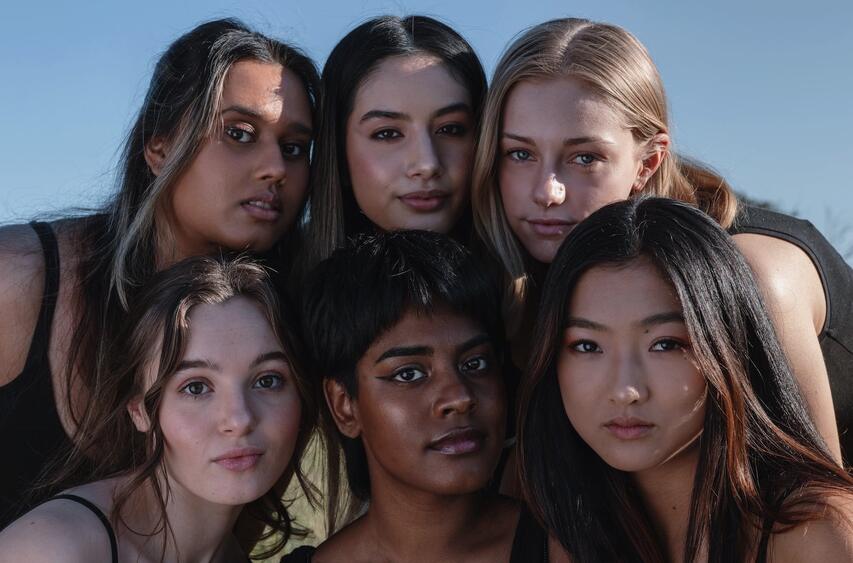
Hair is essential to our identity, with different ethnicities possessing varying hair textures and colors. However, our hair also changes as we age, with signs of aging becoming more prominent. Understanding the unique characteristics of hair aging among different races and ethnicities is crucial for the appropriate management and culturally sensitive recommendations to prevent hair damage. In this article, we will discuss hair aging in different ethnicities, including Caucasians, Hispanics, Asians, and Africans.
Prevalence of hair loss in different ethnicities
Hair loss is a chronic and progressive issue that impacts a significant portion of the population, with at least 40% of men experiencing it by age 50, a number that increases with age, and 50% of women affected by the same age, with a rise in cases post-menopause. Among different ethnic groups,
General Prevalence of Hair Loss:
- Involves at least 40% of men by age 50, increasing with age.
- Impacts 50% of women by age 50, with a higher incidence post-menopause.
Ethnic Variations:
- Hispanic women have a higher incidence of hair loss compared to non-Hispanic White women.
- Male-pattern hair Loss (MPHL) and Female-pattern Hair Loss (FPHL) are common in Asian populations, affecting up to 73% of the general population.
- Japanese men typically develop androgenetic alopecia about ten years later than European men.
Cultural Influences on Hair Loss:
- In China, frontal pattern hair loss is more common among women, possibly linked to the frequent styling of hair in ponytails.
- Due to styling methods such as tight braiding, African hair types are more susceptible to hair loss, which leads to traction alopecia and scarring.
- African American women often use harsh chemicals for hair relaxing and straightening, contributing to hair loss.
Specific Conditions:
- African American women are particularly at risk for centrifugal cicatricial alopecia (CCCA), characterized by inflammation and progressive scarring that destroys hair follicles.
Caucasian Hair Aging
Caucasian hair has a wide range of morphological shapes and physical properties. Hair diameter increases until around the age of 40 and then begins to decrease. Hair density also decreases with increasing age. As melanocytes age, hair becomes more susceptible to oxidative stress, leading to an overall reduction in melanocyte numbers and increasing amounts of gray and white pigmentation in aging hair.
Thermal and color treatments are common among Caucasians, and they can lead to cuticular and cortical damage, and denaturing of hair proteins. Heat and bleaching can weaken hair tensile strength and cause oxidative damage, leading to cellular aging and graying of the hair fiber. To prevent hair damage, it is recommended to limit thermal and color treatments and use appropriate hair care products.
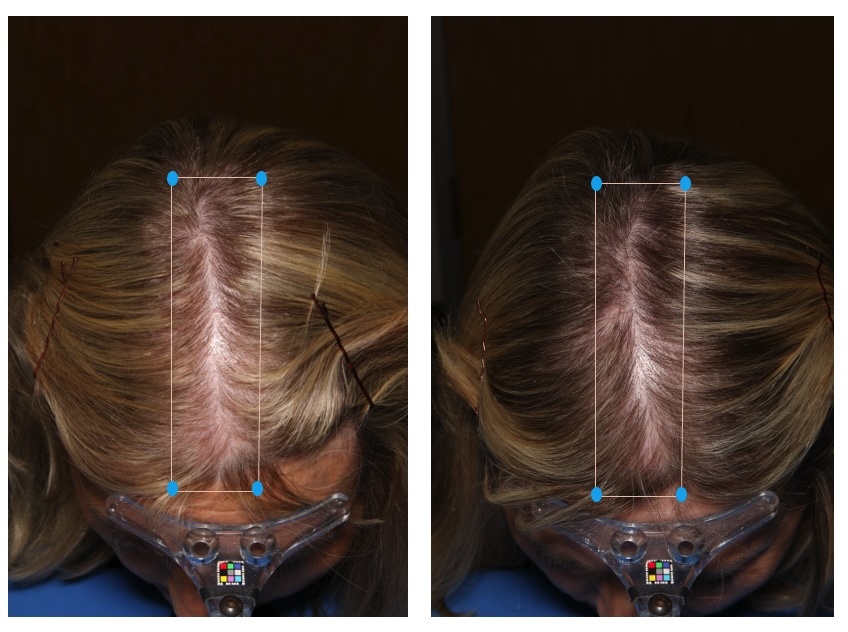
Caucasian woman. Significant improvement in hair density and quality with a visible reduction of hair graying. Before and 24 weeks after treatment with MDhair's Customized treatment kit. MDhair is an IRB-approved clinical study.
Hispanic/Latino Hair Aging
Latino populations have diverse hair appearances due to mixed European, Native American, and African ancestry. The hair diameter of Latinos is similar to Asian hair, but slightly smaller in diameter, ellipticity, and curliness measurements. Hispanics have a lower hair density than Caucasians, but a higher density than individuals of African descent. Cultural practices such as hair dye and keratin straightening treatments are more commonly used among Hispanics than Caucasians. However, these chemical treatments can cause hair damage and accelerate hair aging in Latino populations.
One study found that keratin straightening treatments increased hair fiber breakage and decreased hair elasticity and tensile strength in Hispanic hair. Another study found that hair dye and bleaching treatments increased porosity and reduced the strength of Latino hair. Therefore, it is essential for individuals of Hispanic/Latino ethnicity to understand the unique characteristics of hair aging, and to manage their hair appropriately.
Asian Hair Aging
Asian hair can be straight or curly with a circular hair shaft and a greater diameter than Caucasian or African hair. The increased diameter is due to a broader, more compact cuticle with more cuticle layers that confer resistance to external damage. Hair density in Asians varies with population and decreases slightly with age, but does not result in visible hair loss. Asian hair has a higher hair growth rate than Caucasians.
Hair pigmentation in Asians varies with ancestry and age, and a polymorphism in the dopachrome tautomerase gene is associated with a 20% reduction in pigmentation. Hair lipids in Asians are responsible for moisture, shine, and integrity, and with age, lipids decrease, more pronounced in women than in men. Hairstyles in the Asian population are used to identify sex, age, ethnicity, and social/marital status.
Asian hair reacts differently to external damage, with resistance to straightening treatments, but sensitivity to chemical products. Heat styling tools such as flat irons and hair dryers can damage hair. However, using a heat-protectant product and avoiding excessive heat exposure can help prevent hair damage. Strategies for anti-aging and healthy hair include appropriate grooming habits, careful hair styling, the correct choice of hair products, adequate hair coloring, and medical therapies to address underlying conditions.
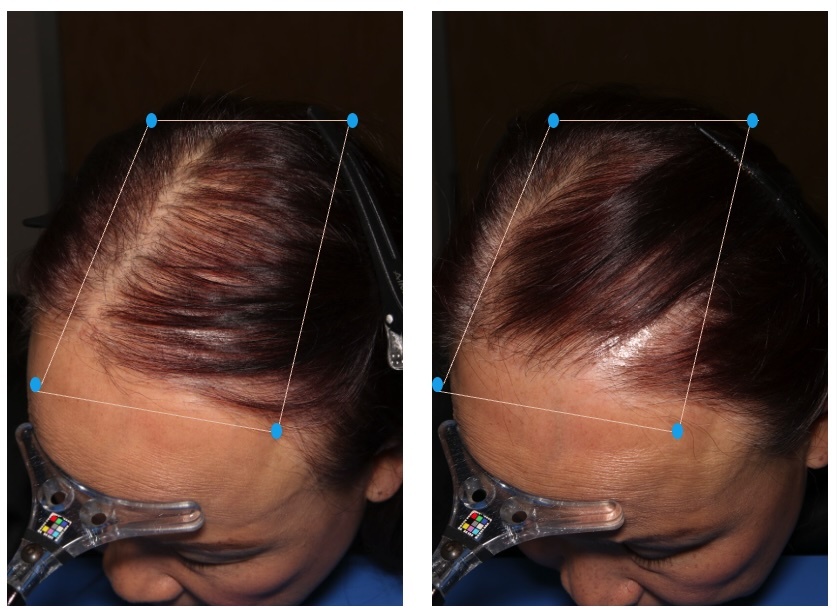
Asian woman. Significant improvement in hair density and quality. Before and 24 weeks after treatment with MDhair's Customized treatment kit. MDhair is an IRB-approved clinical study.
African Hair Aging
African hair has an average diameter of 55µm, the smallest of all hair subgroups. It also has the most significant variability of diameter in a single strand. The density of scalp hair of African ethnicity is less than that of Caucasian and Asian ethnicities, and the density of African hair decreases with age. African hair shafts that have shed are often shorter, with no proximal club and evidence of longitudinal fissures, suggesting that breakage is most commonly how hair is lost.
African hair is intrinsically fragile and thin due to the smaller number of cuticular cell layers, smaller diameter, and longitudinal splitting of the hair shaft with minimal stress. Graying hair is primarily correlated with chronological age, and the average age of onset of gray hair in people of African ethnicity is mid-forties, with premature graying if the onset is before the age of 30.
Unique hairstyles such as cornrows, tight hair ties, braiding, and weaves, common in individuals with African hair, create traction on the scalp, yielding traction alopecia. Chemical relaxers have been shown to remove lipids from the cuticle, making a hair fiber more porous to water, damaging the cell-membrane complex in the process, and decreasing the tensile strength. Hair not only becomes dull when the individual shaft lacks moisture, but also when the oil or sebum from the scalp is diminished.
To prevent damage to African hair, it is recommended to avoid tight hairstyles that put tension on the hair and scalp, as well as harsh chemical treatments such as relaxers. Instead, using natural hair care products that are gentle and moisturizing can help maintain healthy hair. Regular trims and deep conditioning treatments can also help prevent split ends and breakage.
Understanding the unique characteristics of hair aging among different races and ethnicities is essential for the appropriate management and culturally sensitive recommendations to prevent hair damage. It is important to remember that hair care is not a one-size-fits-all solution, and that individualized approaches should be taken based on a person's hair type, ethnicity, and specific needs.
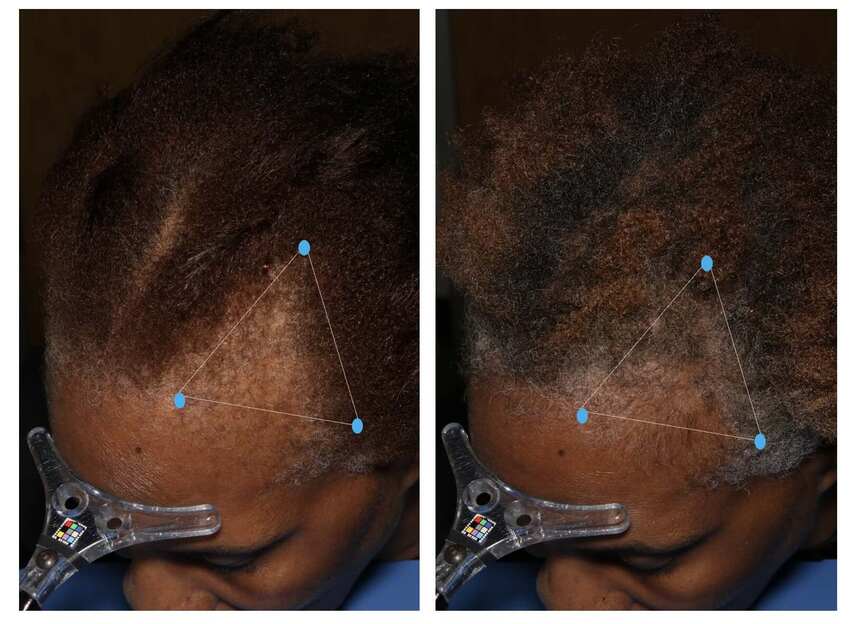
African American woman. Significant improvement in hair density on the temporal areas and hair edges. Before and 24 weeks after treatment with MDhair's Customized treatment kit. MDhair is an IRB-approved clinical study.
Indian Hair Aging
Indian hair typically has a thick, coarse texture with a large diameter, making it strong and resistant to damage. Hair density in Indian populations is high, but hair diameter decreases with age, leading to overall hair thinning. As with other ethnicities, aging Indian hair is more susceptible to oxidative stress, which can lead to gray hair and hair loss. Cultural practices such as oiling and massaging the scalp with natural oils, such as coconut or almond oil, are commonly used in Indian hair care to promote healthy hair growth and prevent hair aging. Additionally, using gentle hair care products and avoiding harsh chemicals and treatments can help maintain the health and integrity of aging Indian hair. It is essential for individuals with Indian hair to understand their hair type and needs, and to take a personalized approach to hair care to prevent hair aging and promote healthy hair growth.
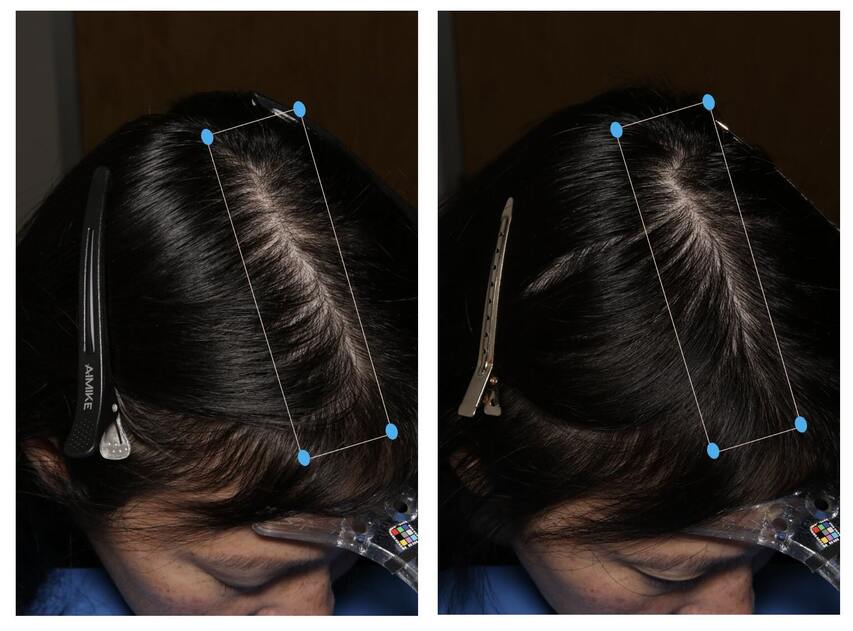
Indian woman. Significant improvement in hair density and quality. Before and 24 weeks after treatment with MDhair's Customized treatment kit. MDhair is an IRB-approved clinical study.
Anti-Aging Haircare Tips for Different Ethnicities
While hair aging is a natural process, there are several things that people of different ethnicities can do to keep their hair healthy and prevent premature aging. Here are some tips for anti-aging hair care:
Caucasian hair:
- Avoid excessive heat styling and chemical treatments.
- Use a heat protectant before using any hot tools on your hair.
- Use shampoos and conditioners specifically formulated for aging hair.
- Regularly trim your hair to prevent split ends and breakage.
- Incorporate into your diet foods rich in vitamins and minerals beneficial for hair health, such as nuts, seeds, and leafy greens.
Hispanic/Latino hair:
- Use shampoos and conditioners specifically formulated for your hair type.
- Avoid excessive use of hot tools and chemical treatments.
- Limit the use of hair ties that can cause tension and breakage.
- Incorporate protein-rich foods, such as beans and lean meats, into your diet to promote hair growth and strength.
- Avoid hairstyles that put too much tension on the scalp.
Asian hair:
- Use gentle shampoos and conditioners formulated for your hair type.
- Avoid excessive use of hot tools and chemical treatments.
- Use hair oils or serums to prevent dryness and damage.
- Incorporate foods rich in omega-3 fatty acids, such as salmon and flax seeds, into your diet to promote healthy hair growth and shine.
- Consider getting a scalp massage to improve blood flow and promote healthy hair growth.
African hair:
- Use sulfate-free shampoos and conditioners specifically formulated for your hair type.
- Avoid excessive use of hot tools and chemical treatments.
- Use natural oils such as coconut oil or shea butter to moisturize and protect your hair.
- Avoid tight hairstyles that cause tension and breakage.
- To promote hair health, incorporate foods rich in vitamin D, such as fatty fish and fortified dairy products, into your diet.
Indian hair:
- Use gentle hair care products specifically formulated for your hair type.
- Avoid harsh chemical treatments, such as coloring or straightening, that can damage the hair and contribute to hair aging.
- To promote healthy hair growth, incorporate foods rich in vitamins and minerals, such as leafy greens, nuts, and seeds, into your diet.
- Regularly trim hair to prevent split ends and breakage, which can contribute to hair aging.
- To prevent damage to the hair, avoid using hot styling tools or use a heat protectant product before using them.
- Manage stress through exercise, meditation, or other relaxation techniques, as stress can contribute to hair aging and thinning.
FAQs:
Q: What causes hair to become thinner as we age?
A: As we age, our bodies produce fewer hormones that promote hair growth, causing hair to become thinner. Additionally, the hair follicles shrink over time, creating thinner strands.
Q: Can excessive use of hair dye accelerate the aging process of hair?
A: Excessive use of hair dye can damage the hair cuticles, making them more susceptible to damage and breakage. This can lead to premature hair aging and thinning.
Q: Are there any supplements or vitamins that can slow hair aging?
A: Biotin, Vitamin D, and Vitamin E are all believed to promote healthy hair growth and slow down the aging process of hair. A daily multivitamin can also provide the necessary nutrients for healthy hair.
Q: How can I protect my hair from UV damage as I age?
A: Wearing a hat or scarf can help protect hair from UV damage. Additionally, using hair care products that contain UV filters can help prevent damage from the sun's rays.
Q: Can stress contribute to premature hair aging?
A: Stress can disrupt the normal hair growth cycle, leading to premature hair aging and thinning. Managing stress through exercise, meditation, or other relaxation techniques can help maintain healthy hair.
Q: What common hair care practices can cause hair damage in Hispanic/Latino populations?
A: Chemical treatments such as hair dye and keratin straightening can cause damage and accelerate hair aging in Hispanic/Latino populations. Additionally, tight hairstyles and hair ties can cause tension and breakage.
Q: Are any specific hair care products recommended for aging hair?
A: Gentle and moisturizing hair care products, such as sulfate-free shampoos and conditioners, are recommended for aging hair.
Q: Can hormonal changes during menopause affect hair aging?
A: Yes, hormonal changes during menopause can lead to hair thinning and loss. Maintaining a healthy diet and using appropriate hair care products to help prevent hair aging during this time is essential.
Q: How does environmental pollution impact hair aging?
A: Environmental pollution can lead to oxidative stress, damaging hair cells and accelerating hair aging. Using hair care products that contain antioxidants can help protect hair from environmental damage.
Q: Why does Asian hair have a greater diameter than other ethnicities?
A: Asian hair has a broader and more compact cuticle with more cuticle layers, providing more resistance to external damage and resulting in a greater diameter.
Q: Can overuse of hair oils cause damage to Asian hair?
A: Yes, overuse of hair oils can weigh down Asian hair and cause it to become greasy and prone to breakage. It is essential to use hair oils in moderation and choose lightweight formulas appropriate for Asian hair.
Q: How does hair pigmentation change with age?
A: Hair pigmentation can decrease with age, leading to gray or white hair. Reduced hair lipids with age can also cause hair to become dull and lose its shine.
Q: Are there any traditional Asian remedies for hair aging?
A: Traditional Asian remedies such as ginseng and green tea are believed to promote healthy hair growth and prevent hair aging. Massaging with active scalp treatment serums can also improve blood flow and promote healthy hair growth.
Q: Can genetics influence the rate of hair aging?
A: Yes, genetics can play a role in the rate of hair aging. Certain genetic variations have been linked to hair pigmentation and hair growth rate.
Q: How does African hair differ from other hair types in structure and density?
A: African hair has the smallest diameter among all hair subgroups, the most significant variability of diameter in a single strand, and a smaller number of cuticular cell layers. The density of scalp hair is also less than that of other ethnicities.
Q: What are some common hair care practices that can contribute to hair damage and aging in African populations?
A: Chemical relaxers and tight hairstyles such as braids and weaves can cause hair damage and contribute to hair aging in African populations. Additionally, harsh shampoos and conditioners can strip the hair of its natural oils, making it more prone to damage.
Q: Are any specific hair care products recommended for aging hair in African populations?
A: Sulfate-free shampoos and gentle, moisturizing conditioners are recommended for aging hair in African populations. Natural oils such as coconut oil or shea butter can also be used to moisturize and protect hair.
Q: How can I prevent hair breakage and loss in African hair as I age?
A: To prevent hair breakage and loss, it is recommended to avoid tight hairstyles that cause tension and breakage, use natural hair care products that are gentle and moisturizing, and incorporate foods rich in vitamin D into your diet to promote hair health. Regular trims and deep conditioning treatments can also help prevent split ends and breakage.
Q: How do unique hairstyles such as cornrows affect African hair aging?
A: Unique hairstyles such as cornrows can create tension on the scalp, leading to traction alopecia and hair loss. It is essential to avoid hairstyles that put too much tension on the hair and scalp to prevent damage and hair aging.
Q: Can natural oils help prevent hair aging in African hair?
A: Yes, natural oils such as coconut oil or shea butter can be used to moisturize and protect African hair from damage, which can help prevent hair aging and breakage.
Q: What foods should I incorporate into my diet to promote healthy hair growth?
A: Foods rich in vitamin D, such as fatty fish and fortified dairy products, can promote healthy hair growth and help prevent hair aging. Additionally, foods rich in protein, such as beans and lean meats, can promote hair strength and growth.
Q: Why is it important to use sulfate-free shampoos and conditioners for African hair?
A: Sulfate-free shampoos and conditioners are less harsh and do not strip the hair of its natural oils, making them gentler and less likely to contribute to hair aging and damage in African hair.
Q: How does the use of chemical relaxers affect African hair aging?
A: Chemical relaxers can remove lipids from the cuticle, which creates a hair fiber that is more porous, and damages the cell-membrane complex in the process. This can contribute to hair aging and breakage in African hair.
Q: Can certain medications contribute to hair aging in different ethnicities?
A: Yes, certain medications can contribute to hair aging and thinning in different ethnicities. It is important to consult with a healthcare provider if you are experiencing hair loss or thinning to determine if medication may be a contributing factor.
Q: Can lifestyle factors contribute to hair aging in all ethnicities?
A: Yes, lifestyle factors such as smoking, excessive alcohol consumption, and a poor diet can contribute to hair aging in all ethnicities. Maintaining a healthy lifestyle is important to promote overall health and healthy hair growth.
Q: Can regular exercise help prevent hair aging in all ethnicities?
A: Yes, regular exercise can improve overall health and blood flow, which can promote healthy hair growth and prevent hair aging in all ethnicities.
Q: How often should I trim my hair to prevent hair aging?
A: It is recommended that hair be trimmed every 6-8 weeks to prevent split ends and breakage, which can contribute to hair aging.
Q: Can the use of hair care products too often contribute to hair aging?
A: Yes, using hair care products too often or using products that contain harsh chemicals can contribute to hair aging and damage. It is important to use gentle products that are specifically formulated for your hair type and to avoid overusing them.
Find the most effective hair growth products for you by taking the free hair assessment.



